Report: Information System Analysis for Windermere College (Unit 4.53)
VerifiedAdded on 2021/02/20
|21
|6152
|288
Report
AI Summary
This report provides a comprehensive analysis of the information system used by Windermere College. It begins with an introduction to information systems, highlighting their importance in modern business operations. The report then delves into a comparative analysis of Windermere College's MIS with that of Imperial College, assessing the effectiveness of the existing system, and identifying the need for information systems in different functional areas of the college, including human resources, accounting, and operations. The report further assesses the project feasibility of a new MIS, outlining a project plan for its development. It explores various performance measurement techniques and their significance, offering recommendations for improving the system's security, data accuracy, and overall functionality. The report concludes with a summary of findings and suggestions for future improvements, providing valuable insights into the college's information system and its potential for enhancement.
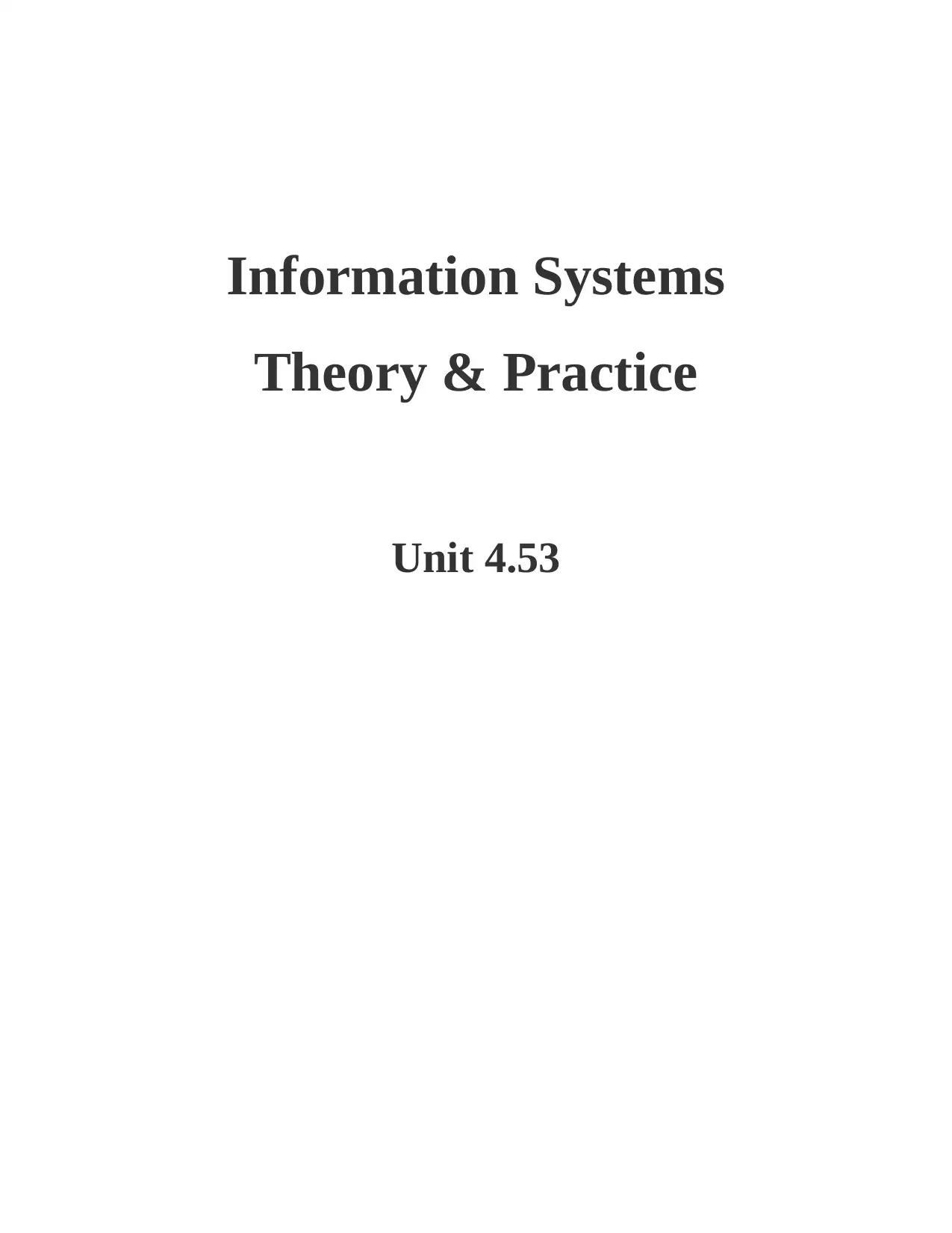
Information Systems
Theory & Practice
Unit 4.53
Theory & Practice
Unit 4.53
Paraphrase This Document
Need a fresh take? Get an instant paraphrase of this document with our AI Paraphraser
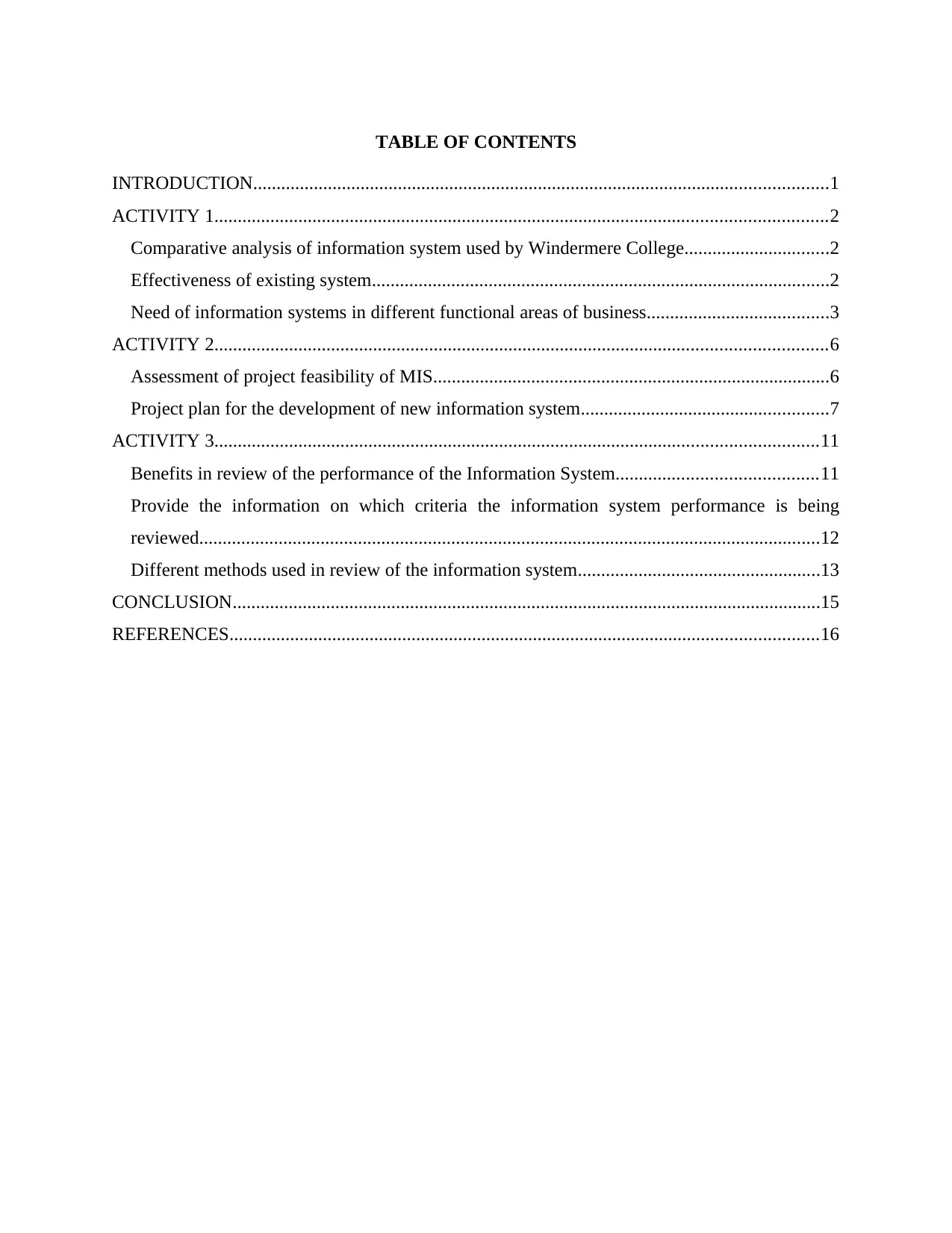
TABLE OF CONTENTS
INTRODUCTION...........................................................................................................................1
ACTIVITY 1...................................................................................................................................2
Comparative analysis of information system used by Windermere College...............................2
Effectiveness of existing system..................................................................................................2
Need of information systems in different functional areas of business.......................................3
ACTIVITY 2...................................................................................................................................6
Assessment of project feasibility of MIS.....................................................................................6
Project plan for the development of new information system.....................................................7
ACTIVITY 3.................................................................................................................................11
Benefits in review of the performance of the Information System...........................................11
Provide the information on which criteria the information system performance is being
reviewed.....................................................................................................................................12
Different methods used in review of the information system....................................................13
CONCLUSION..............................................................................................................................15
REFERENCES..............................................................................................................................16
INTRODUCTION...........................................................................................................................1
ACTIVITY 1...................................................................................................................................2
Comparative analysis of information system used by Windermere College...............................2
Effectiveness of existing system..................................................................................................2
Need of information systems in different functional areas of business.......................................3
ACTIVITY 2...................................................................................................................................6
Assessment of project feasibility of MIS.....................................................................................6
Project plan for the development of new information system.....................................................7
ACTIVITY 3.................................................................................................................................11
Benefits in review of the performance of the Information System...........................................11
Provide the information on which criteria the information system performance is being
reviewed.....................................................................................................................................12
Different methods used in review of the information system....................................................13
CONCLUSION..............................................................................................................................15
REFERENCES..............................................................................................................................16
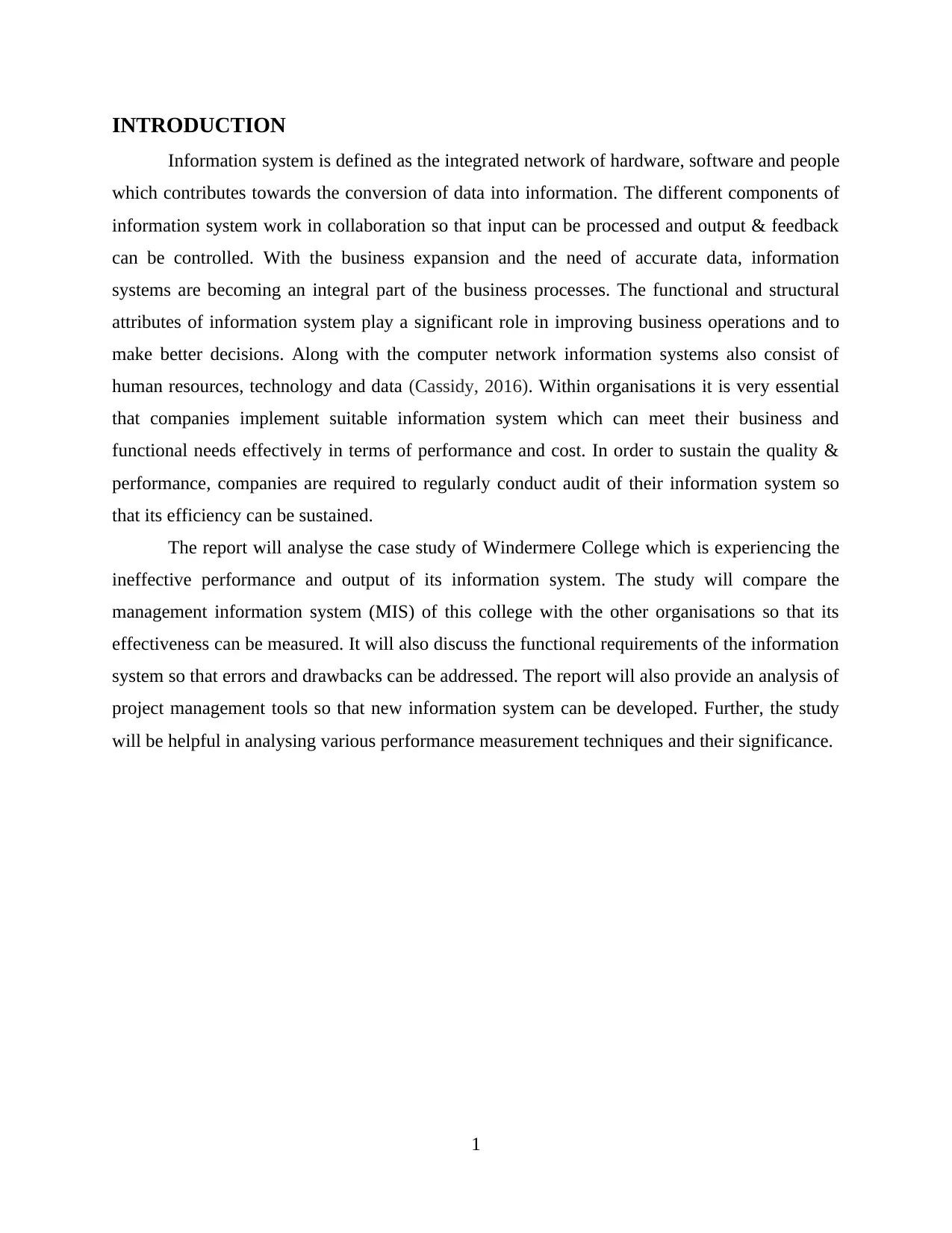
INTRODUCTION
Information system is defined as the integrated network of hardware, software and people
which contributes towards the conversion of data into information. The different components of
information system work in collaboration so that input can be processed and output & feedback
can be controlled. With the business expansion and the need of accurate data, information
systems are becoming an integral part of the business processes. The functional and structural
attributes of information system play a significant role in improving business operations and to
make better decisions. Along with the computer network information systems also consist of
human resources, technology and data (Cassidy, 2016). Within organisations it is very essential
that companies implement suitable information system which can meet their business and
functional needs effectively in terms of performance and cost. In order to sustain the quality &
performance, companies are required to regularly conduct audit of their information system so
that its efficiency can be sustained.
The report will analyse the case study of Windermere College which is experiencing the
ineffective performance and output of its information system. The study will compare the
management information system (MIS) of this college with the other organisations so that its
effectiveness can be measured. It will also discuss the functional requirements of the information
system so that errors and drawbacks can be addressed. The report will also provide an analysis of
project management tools so that new information system can be developed. Further, the study
will be helpful in analysing various performance measurement techniques and their significance.
1
Information system is defined as the integrated network of hardware, software and people
which contributes towards the conversion of data into information. The different components of
information system work in collaboration so that input can be processed and output & feedback
can be controlled. With the business expansion and the need of accurate data, information
systems are becoming an integral part of the business processes. The functional and structural
attributes of information system play a significant role in improving business operations and to
make better decisions. Along with the computer network information systems also consist of
human resources, technology and data (Cassidy, 2016). Within organisations it is very essential
that companies implement suitable information system which can meet their business and
functional needs effectively in terms of performance and cost. In order to sustain the quality &
performance, companies are required to regularly conduct audit of their information system so
that its efficiency can be sustained.
The report will analyse the case study of Windermere College which is experiencing the
ineffective performance and output of its information system. The study will compare the
management information system (MIS) of this college with the other organisations so that its
effectiveness can be measured. It will also discuss the functional requirements of the information
system so that errors and drawbacks can be addressed. The report will also provide an analysis of
project management tools so that new information system can be developed. Further, the study
will be helpful in analysing various performance measurement techniques and their significance.
1
⊘ This is a preview!⊘
Do you want full access?
Subscribe today to unlock all pages.

Trusted by 1+ million students worldwide
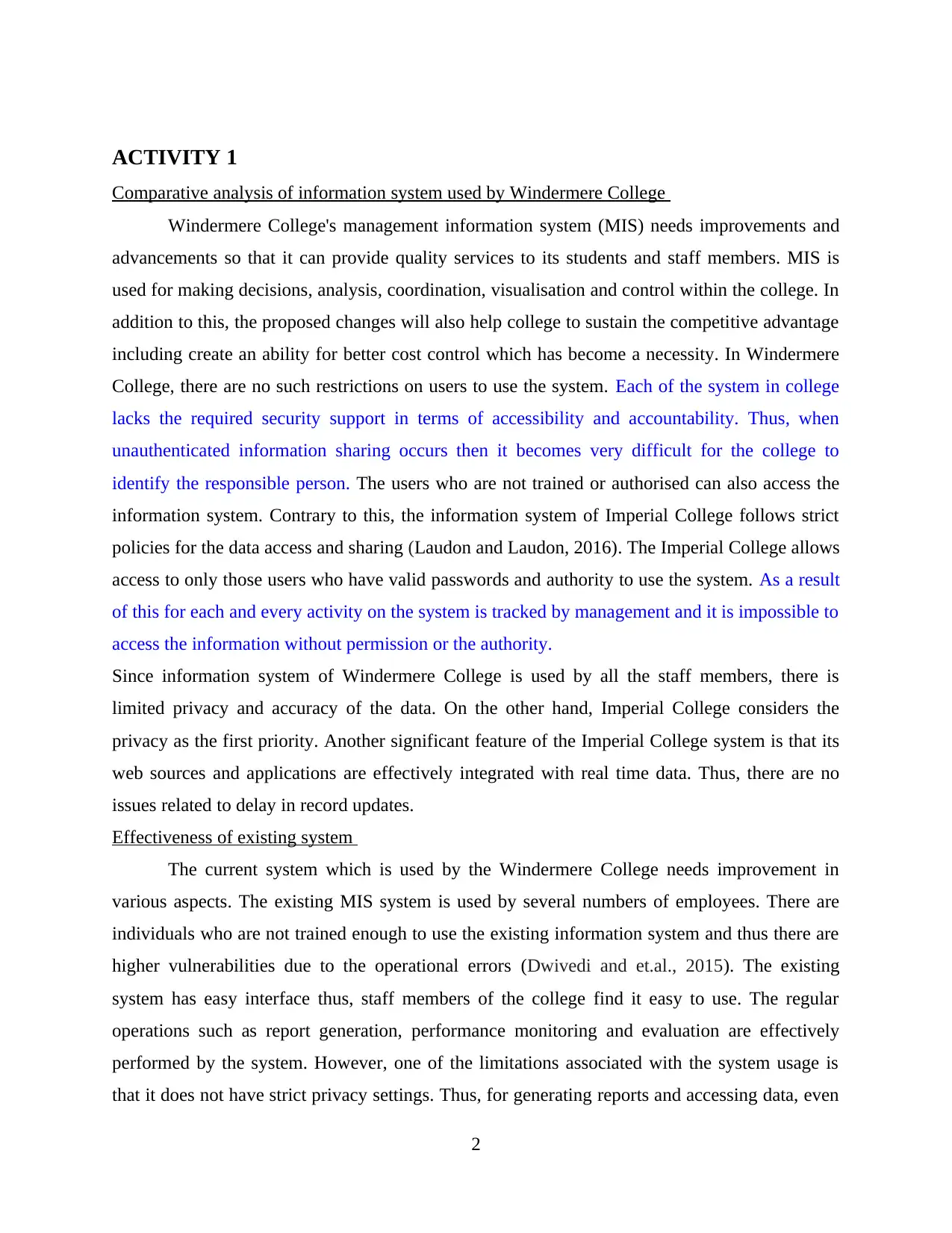
ACTIVITY 1
Comparative analysis of information system used by Windermere College
Windermere College's management information system (MIS) needs improvements and
advancements so that it can provide quality services to its students and staff members. MIS is
used for making decisions, analysis, coordination, visualisation and control within the college. In
addition to this, the proposed changes will also help college to sustain the competitive advantage
including create an ability for better cost control which has become a necessity. In Windermere
College, there are no such restrictions on users to use the system. Each of the system in college
lacks the required security support in terms of accessibility and accountability. Thus, when
unauthenticated information sharing occurs then it becomes very difficult for the college to
identify the responsible person. The users who are not trained or authorised can also access the
information system. Contrary to this, the information system of Imperial College follows strict
policies for the data access and sharing (Laudon and Laudon, 2016). The Imperial College allows
access to only those users who have valid passwords and authority to use the system. As a result
of this for each and every activity on the system is tracked by management and it is impossible to
access the information without permission or the authority.
Since information system of Windermere College is used by all the staff members, there is
limited privacy and accuracy of the data. On the other hand, Imperial College considers the
privacy as the first priority. Another significant feature of the Imperial College system is that its
web sources and applications are effectively integrated with real time data. Thus, there are no
issues related to delay in record updates.
Effectiveness of existing system
The current system which is used by the Windermere College needs improvement in
various aspects. The existing MIS system is used by several numbers of employees. There are
individuals who are not trained enough to use the existing information system and thus there are
higher vulnerabilities due to the operational errors (Dwivedi and et.al., 2015). The existing
system has easy interface thus, staff members of the college find it easy to use. The regular
operations such as report generation, performance monitoring and evaluation are effectively
performed by the system. However, one of the limitations associated with the system usage is
that it does not have strict privacy settings. Thus, for generating reports and accessing data, even
2
Comparative analysis of information system used by Windermere College
Windermere College's management information system (MIS) needs improvements and
advancements so that it can provide quality services to its students and staff members. MIS is
used for making decisions, analysis, coordination, visualisation and control within the college. In
addition to this, the proposed changes will also help college to sustain the competitive advantage
including create an ability for better cost control which has become a necessity. In Windermere
College, there are no such restrictions on users to use the system. Each of the system in college
lacks the required security support in terms of accessibility and accountability. Thus, when
unauthenticated information sharing occurs then it becomes very difficult for the college to
identify the responsible person. The users who are not trained or authorised can also access the
information system. Contrary to this, the information system of Imperial College follows strict
policies for the data access and sharing (Laudon and Laudon, 2016). The Imperial College allows
access to only those users who have valid passwords and authority to use the system. As a result
of this for each and every activity on the system is tracked by management and it is impossible to
access the information without permission or the authority.
Since information system of Windermere College is used by all the staff members, there is
limited privacy and accuracy of the data. On the other hand, Imperial College considers the
privacy as the first priority. Another significant feature of the Imperial College system is that its
web sources and applications are effectively integrated with real time data. Thus, there are no
issues related to delay in record updates.
Effectiveness of existing system
The current system which is used by the Windermere College needs improvement in
various aspects. The existing MIS system is used by several numbers of employees. There are
individuals who are not trained enough to use the existing information system and thus there are
higher vulnerabilities due to the operational errors (Dwivedi and et.al., 2015). The existing
system has easy interface thus, staff members of the college find it easy to use. The regular
operations such as report generation, performance monitoring and evaluation are effectively
performed by the system. However, one of the limitations associated with the system usage is
that it does not have strict privacy settings. Thus, for generating reports and accessing data, even
2
Paraphrase This Document
Need a fresh take? Get an instant paraphrase of this document with our AI Paraphraser
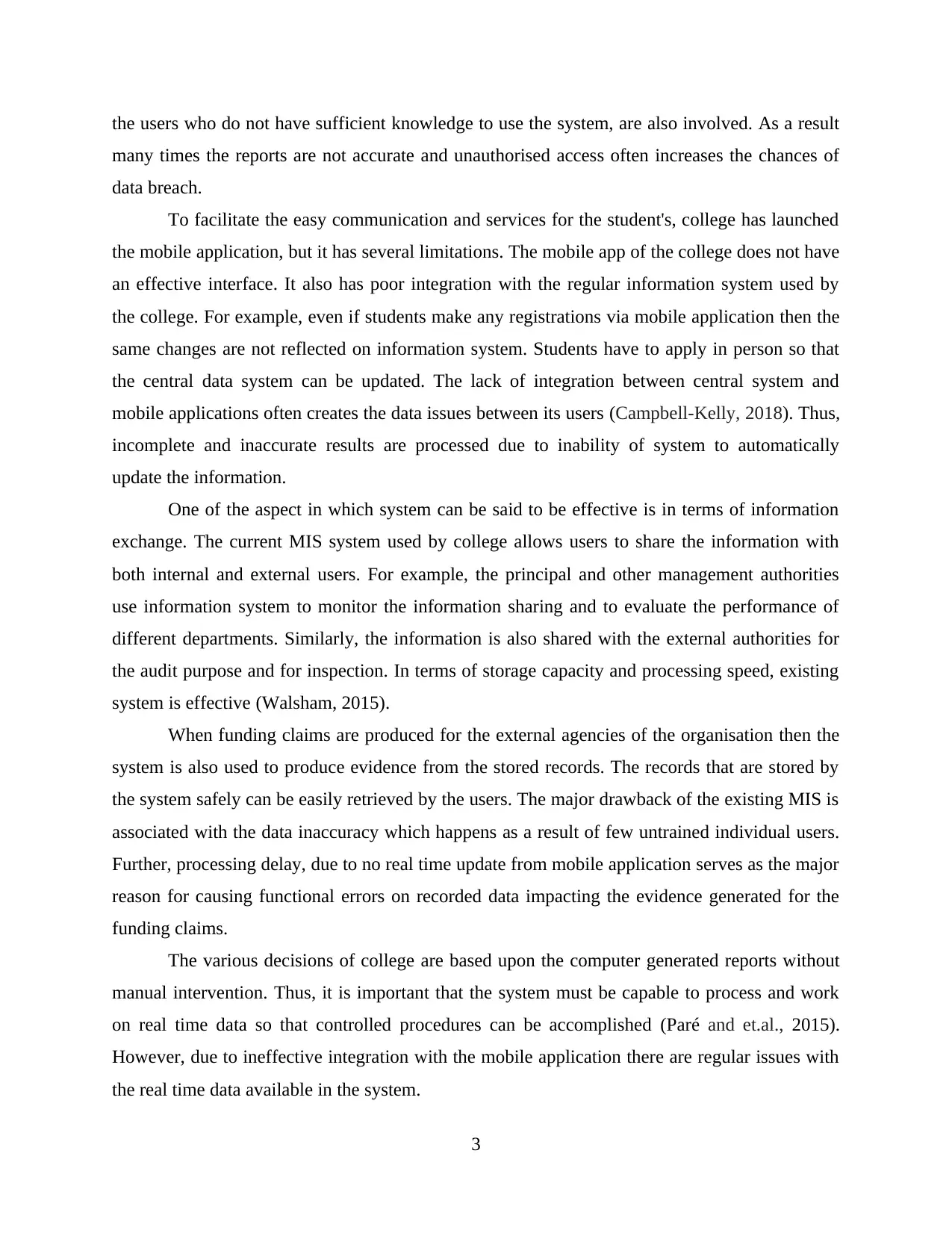
the users who do not have sufficient knowledge to use the system, are also involved. As a result
many times the reports are not accurate and unauthorised access often increases the chances of
data breach.
To facilitate the easy communication and services for the student's, college has launched
the mobile application, but it has several limitations. The mobile app of the college does not have
an effective interface. It also has poor integration with the regular information system used by
the college. For example, even if students make any registrations via mobile application then the
same changes are not reflected on information system. Students have to apply in person so that
the central data system can be updated. The lack of integration between central system and
mobile applications often creates the data issues between its users (Campbell-Kelly, 2018). Thus,
incomplete and inaccurate results are processed due to inability of system to automatically
update the information.
One of the aspect in which system can be said to be effective is in terms of information
exchange. The current MIS system used by college allows users to share the information with
both internal and external users. For example, the principal and other management authorities
use information system to monitor the information sharing and to evaluate the performance of
different departments. Similarly, the information is also shared with the external authorities for
the audit purpose and for inspection. In terms of storage capacity and processing speed, existing
system is effective (Walsham, 2015).
When funding claims are produced for the external agencies of the organisation then the
system is also used to produce evidence from the stored records. The records that are stored by
the system safely can be easily retrieved by the users. The major drawback of the existing MIS is
associated with the data inaccuracy which happens as a result of few untrained individual users.
Further, processing delay, due to no real time update from mobile application serves as the major
reason for causing functional errors on recorded data impacting the evidence generated for the
funding claims.
The various decisions of college are based upon the computer generated reports without
manual intervention. Thus, it is important that the system must be capable to process and work
on real time data so that controlled procedures can be accomplished (Paré and et.al., 2015).
However, due to ineffective integration with the mobile application there are regular issues with
the real time data available in the system.
3
many times the reports are not accurate and unauthorised access often increases the chances of
data breach.
To facilitate the easy communication and services for the student's, college has launched
the mobile application, but it has several limitations. The mobile app of the college does not have
an effective interface. It also has poor integration with the regular information system used by
the college. For example, even if students make any registrations via mobile application then the
same changes are not reflected on information system. Students have to apply in person so that
the central data system can be updated. The lack of integration between central system and
mobile applications often creates the data issues between its users (Campbell-Kelly, 2018). Thus,
incomplete and inaccurate results are processed due to inability of system to automatically
update the information.
One of the aspect in which system can be said to be effective is in terms of information
exchange. The current MIS system used by college allows users to share the information with
both internal and external users. For example, the principal and other management authorities
use information system to monitor the information sharing and to evaluate the performance of
different departments. Similarly, the information is also shared with the external authorities for
the audit purpose and for inspection. In terms of storage capacity and processing speed, existing
system is effective (Walsham, 2015).
When funding claims are produced for the external agencies of the organisation then the
system is also used to produce evidence from the stored records. The records that are stored by
the system safely can be easily retrieved by the users. The major drawback of the existing MIS is
associated with the data inaccuracy which happens as a result of few untrained individual users.
Further, processing delay, due to no real time update from mobile application serves as the major
reason for causing functional errors on recorded data impacting the evidence generated for the
funding claims.
The various decisions of college are based upon the computer generated reports without
manual intervention. Thus, it is important that the system must be capable to process and work
on real time data so that controlled procedures can be accomplished (Paré and et.al., 2015).
However, due to ineffective integration with the mobile application there are regular issues with
the real time data available in the system.
3
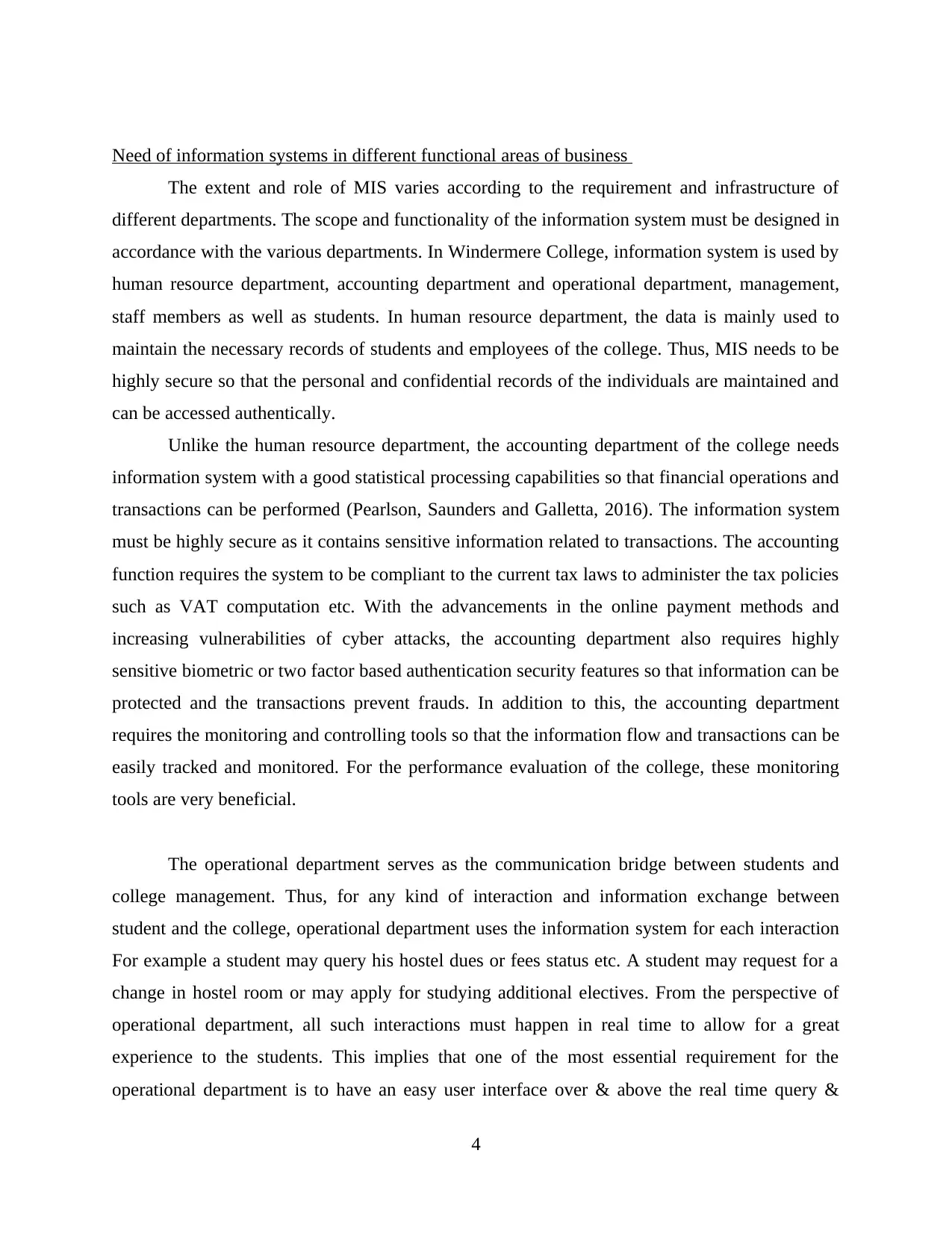
Need of information systems in different functional areas of business
The extent and role of MIS varies according to the requirement and infrastructure of
different departments. The scope and functionality of the information system must be designed in
accordance with the various departments. In Windermere College, information system is used by
human resource department, accounting department and operational department, management,
staff members as well as students. In human resource department, the data is mainly used to
maintain the necessary records of students and employees of the college. Thus, MIS needs to be
highly secure so that the personal and confidential records of the individuals are maintained and
can be accessed authentically.
Unlike the human resource department, the accounting department of the college needs
information system with a good statistical processing capabilities so that financial operations and
transactions can be performed (Pearlson, Saunders and Galletta, 2016). The information system
must be highly secure as it contains sensitive information related to transactions. The accounting
function requires the system to be compliant to the current tax laws to administer the tax policies
such as VAT computation etc. With the advancements in the online payment methods and
increasing vulnerabilities of cyber attacks, the accounting department also requires highly
sensitive biometric or two factor based authentication security features so that information can be
protected and the transactions prevent frauds. In addition to this, the accounting department
requires the monitoring and controlling tools so that the information flow and transactions can be
easily tracked and monitored. For the performance evaluation of the college, these monitoring
tools are very beneficial.
The operational department serves as the communication bridge between students and
college management. Thus, for any kind of interaction and information exchange between
student and the college, operational department uses the information system for each interaction
For example a student may query his hostel dues or fees status etc. A student may request for a
change in hostel room or may apply for studying additional electives. From the perspective of
operational department, all such interactions must happen in real time to allow for a great
experience to the students. This implies that one of the most essential requirement for the
operational department is to have an easy user interface over & above the real time query &
4
The extent and role of MIS varies according to the requirement and infrastructure of
different departments. The scope and functionality of the information system must be designed in
accordance with the various departments. In Windermere College, information system is used by
human resource department, accounting department and operational department, management,
staff members as well as students. In human resource department, the data is mainly used to
maintain the necessary records of students and employees of the college. Thus, MIS needs to be
highly secure so that the personal and confidential records of the individuals are maintained and
can be accessed authentically.
Unlike the human resource department, the accounting department of the college needs
information system with a good statistical processing capabilities so that financial operations and
transactions can be performed (Pearlson, Saunders and Galletta, 2016). The information system
must be highly secure as it contains sensitive information related to transactions. The accounting
function requires the system to be compliant to the current tax laws to administer the tax policies
such as VAT computation etc. With the advancements in the online payment methods and
increasing vulnerabilities of cyber attacks, the accounting department also requires highly
sensitive biometric or two factor based authentication security features so that information can be
protected and the transactions prevent frauds. In addition to this, the accounting department
requires the monitoring and controlling tools so that the information flow and transactions can be
easily tracked and monitored. For the performance evaluation of the college, these monitoring
tools are very beneficial.
The operational department serves as the communication bridge between students and
college management. Thus, for any kind of interaction and information exchange between
student and the college, operational department uses the information system for each interaction
For example a student may query his hostel dues or fees status etc. A student may request for a
change in hostel room or may apply for studying additional electives. From the perspective of
operational department, all such interactions must happen in real time to allow for a great
experience to the students. This implies that one of the most essential requirement for the
operational department is to have an easy user interface over & above the real time query &
4
⊘ This is a preview!⊘
Do you want full access?
Subscribe today to unlock all pages.

Trusted by 1+ million students worldwide
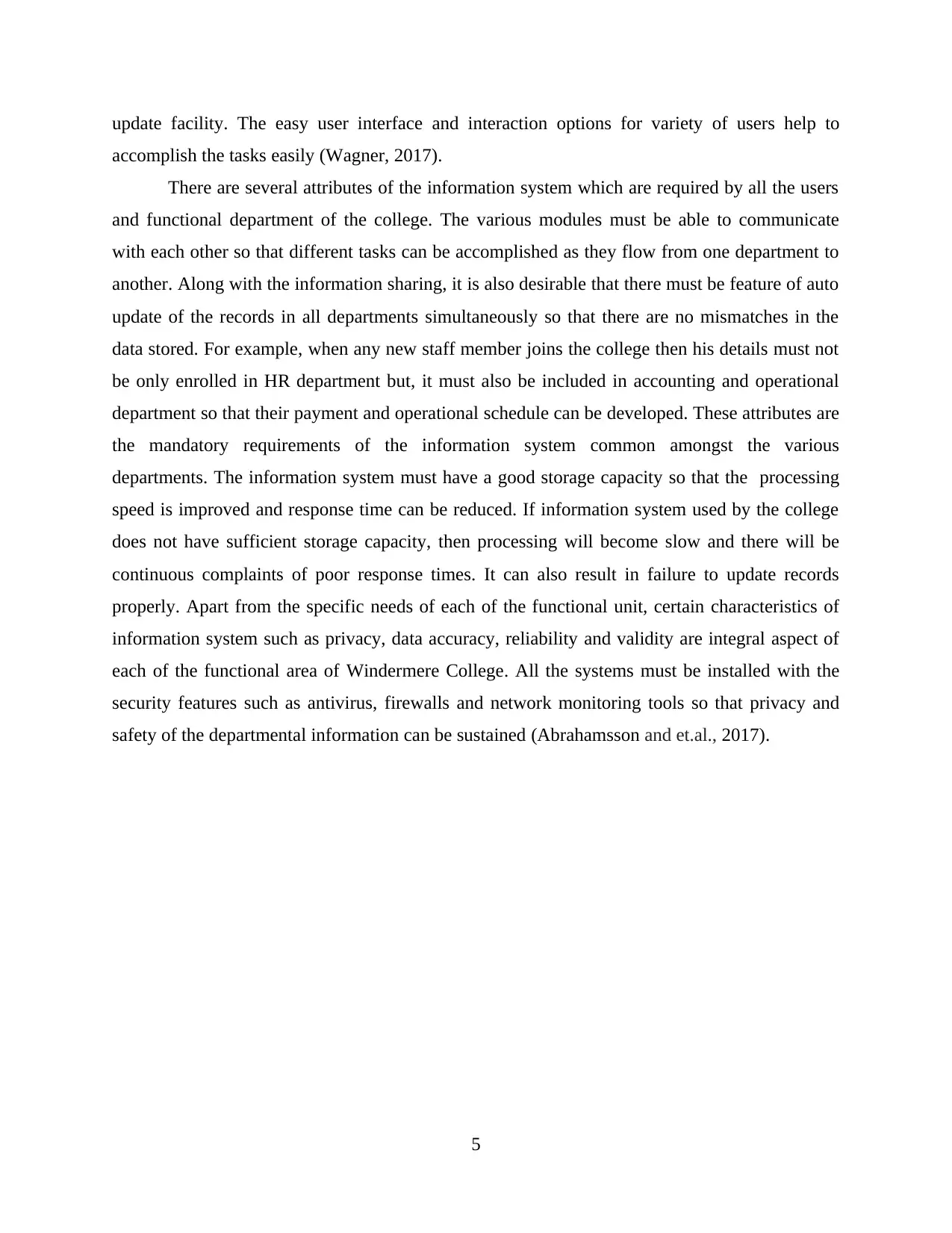
update facility. The easy user interface and interaction options for variety of users help to
accomplish the tasks easily (Wagner, 2017).
There are several attributes of the information system which are required by all the users
and functional department of the college. The various modules must be able to communicate
with each other so that different tasks can be accomplished as they flow from one department to
another. Along with the information sharing, it is also desirable that there must be feature of auto
update of the records in all departments simultaneously so that there are no mismatches in the
data stored. For example, when any new staff member joins the college then his details must not
be only enrolled in HR department but, it must also be included in accounting and operational
department so that their payment and operational schedule can be developed. These attributes are
the mandatory requirements of the information system common amongst the various
departments. The information system must have a good storage capacity so that the processing
speed is improved and response time can be reduced. If information system used by the college
does not have sufficient storage capacity, then processing will become slow and there will be
continuous complaints of poor response times. It can also result in failure to update records
properly. Apart from the specific needs of each of the functional unit, certain characteristics of
information system such as privacy, data accuracy, reliability and validity are integral aspect of
each of the functional area of Windermere College. All the systems must be installed with the
security features such as antivirus, firewalls and network monitoring tools so that privacy and
safety of the departmental information can be sustained (Abrahamsson and et.al., 2017).
5
accomplish the tasks easily (Wagner, 2017).
There are several attributes of the information system which are required by all the users
and functional department of the college. The various modules must be able to communicate
with each other so that different tasks can be accomplished as they flow from one department to
another. Along with the information sharing, it is also desirable that there must be feature of auto
update of the records in all departments simultaneously so that there are no mismatches in the
data stored. For example, when any new staff member joins the college then his details must not
be only enrolled in HR department but, it must also be included in accounting and operational
department so that their payment and operational schedule can be developed. These attributes are
the mandatory requirements of the information system common amongst the various
departments. The information system must have a good storage capacity so that the processing
speed is improved and response time can be reduced. If information system used by the college
does not have sufficient storage capacity, then processing will become slow and there will be
continuous complaints of poor response times. It can also result in failure to update records
properly. Apart from the specific needs of each of the functional unit, certain characteristics of
information system such as privacy, data accuracy, reliability and validity are integral aspect of
each of the functional area of Windermere College. All the systems must be installed with the
security features such as antivirus, firewalls and network monitoring tools so that privacy and
safety of the departmental information can be sustained (Abrahamsson and et.al., 2017).
5
Paraphrase This Document
Need a fresh take? Get an instant paraphrase of this document with our AI Paraphraser
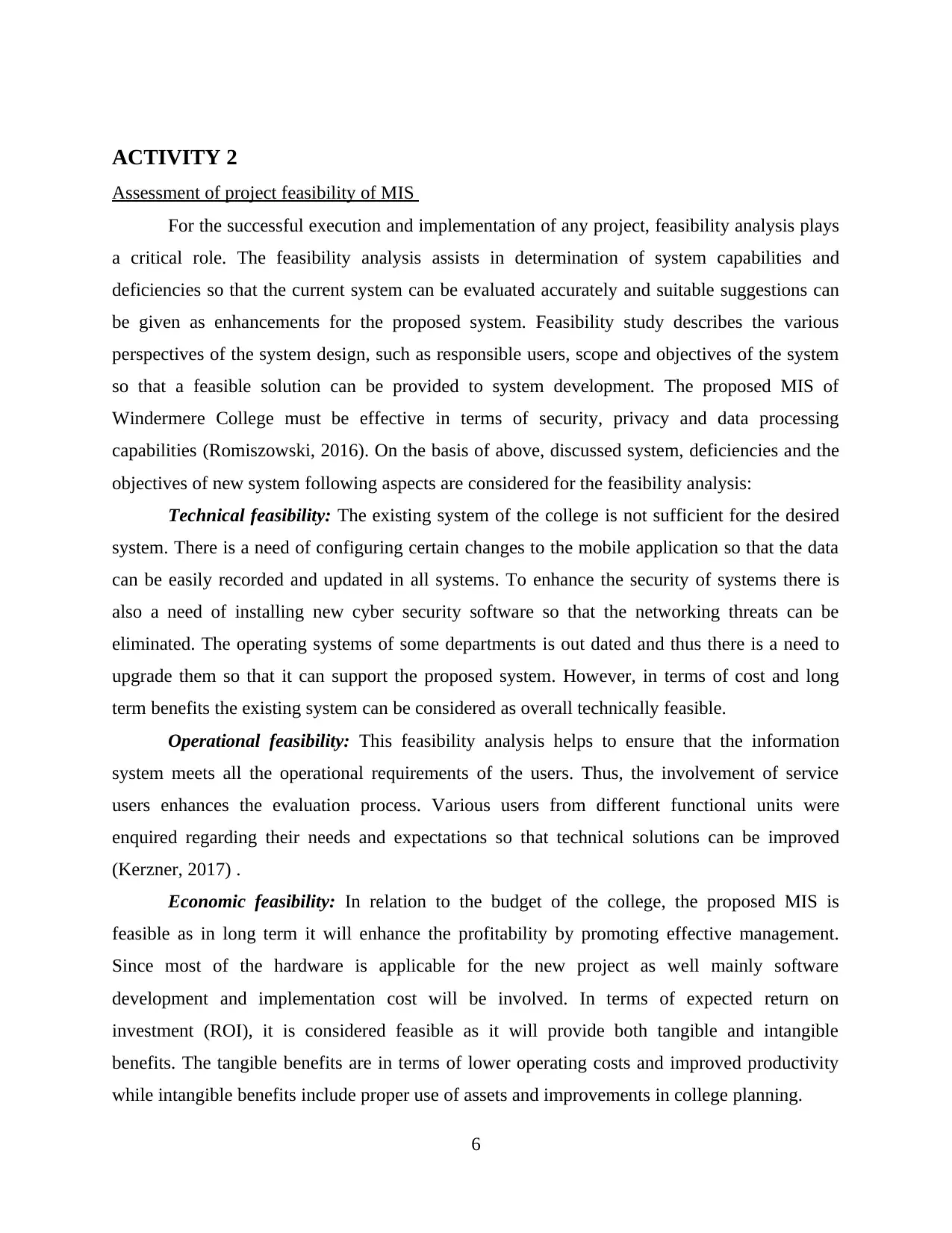
ACTIVITY 2
Assessment of project feasibility of MIS
For the successful execution and implementation of any project, feasibility analysis plays
a critical role. The feasibility analysis assists in determination of system capabilities and
deficiencies so that the current system can be evaluated accurately and suitable suggestions can
be given as enhancements for the proposed system. Feasibility study describes the various
perspectives of the system design, such as responsible users, scope and objectives of the system
so that a feasible solution can be provided to system development. The proposed MIS of
Windermere College must be effective in terms of security, privacy and data processing
capabilities (Romiszowski, 2016). On the basis of above, discussed system, deficiencies and the
objectives of new system following aspects are considered for the feasibility analysis:
Technical feasibility: The existing system of the college is not sufficient for the desired
system. There is a need of configuring certain changes to the mobile application so that the data
can be easily recorded and updated in all systems. To enhance the security of systems there is
also a need of installing new cyber security software so that the networking threats can be
eliminated. The operating systems of some departments is out dated and thus there is a need to
upgrade them so that it can support the proposed system. However, in terms of cost and long
term benefits the existing system can be considered as overall technically feasible.
Operational feasibility: This feasibility analysis helps to ensure that the information
system meets all the operational requirements of the users. Thus, the involvement of service
users enhances the evaluation process. Various users from different functional units were
enquired regarding their needs and expectations so that technical solutions can be improved
(Kerzner, 2017) .
Economic feasibility: In relation to the budget of the college, the proposed MIS is
feasible as in long term it will enhance the profitability by promoting effective management.
Since most of the hardware is applicable for the new project as well mainly software
development and implementation cost will be involved. In terms of expected return on
investment (ROI), it is considered feasible as it will provide both tangible and intangible
benefits. The tangible benefits are in terms of lower operating costs and improved productivity
while intangible benefits include proper use of assets and improvements in college planning.
6
Assessment of project feasibility of MIS
For the successful execution and implementation of any project, feasibility analysis plays
a critical role. The feasibility analysis assists in determination of system capabilities and
deficiencies so that the current system can be evaluated accurately and suitable suggestions can
be given as enhancements for the proposed system. Feasibility study describes the various
perspectives of the system design, such as responsible users, scope and objectives of the system
so that a feasible solution can be provided to system development. The proposed MIS of
Windermere College must be effective in terms of security, privacy and data processing
capabilities (Romiszowski, 2016). On the basis of above, discussed system, deficiencies and the
objectives of new system following aspects are considered for the feasibility analysis:
Technical feasibility: The existing system of the college is not sufficient for the desired
system. There is a need of configuring certain changes to the mobile application so that the data
can be easily recorded and updated in all systems. To enhance the security of systems there is
also a need of installing new cyber security software so that the networking threats can be
eliminated. The operating systems of some departments is out dated and thus there is a need to
upgrade them so that it can support the proposed system. However, in terms of cost and long
term benefits the existing system can be considered as overall technically feasible.
Operational feasibility: This feasibility analysis helps to ensure that the information
system meets all the operational requirements of the users. Thus, the involvement of service
users enhances the evaluation process. Various users from different functional units were
enquired regarding their needs and expectations so that technical solutions can be improved
(Kerzner, 2017) .
Economic feasibility: In relation to the budget of the college, the proposed MIS is
feasible as in long term it will enhance the profitability by promoting effective management.
Since most of the hardware is applicable for the new project as well mainly software
development and implementation cost will be involved. In terms of expected return on
investment (ROI), it is considered feasible as it will provide both tangible and intangible
benefits. The tangible benefits are in terms of lower operating costs and improved productivity
while intangible benefits include proper use of assets and improvements in college planning.
6
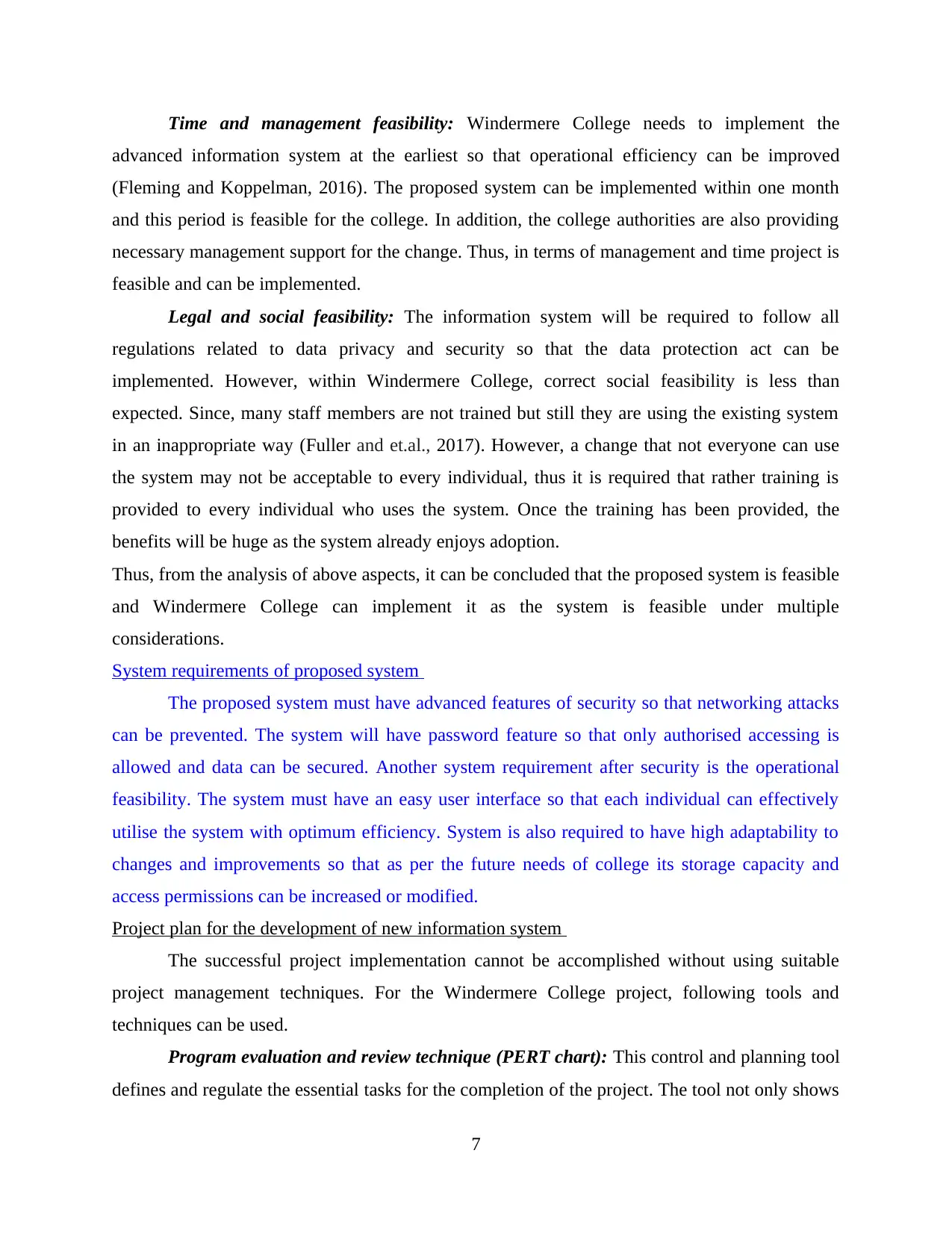
Time and management feasibility: Windermere College needs to implement the
advanced information system at the earliest so that operational efficiency can be improved
(Fleming and Koppelman, 2016). The proposed system can be implemented within one month
and this period is feasible for the college. In addition, the college authorities are also providing
necessary management support for the change. Thus, in terms of management and time project is
feasible and can be implemented.
Legal and social feasibility: The information system will be required to follow all
regulations related to data privacy and security so that the data protection act can be
implemented. However, within Windermere College, correct social feasibility is less than
expected. Since, many staff members are not trained but still they are using the existing system
in an inappropriate way (Fuller and et.al., 2017). However, a change that not everyone can use
the system may not be acceptable to every individual, thus it is required that rather training is
provided to every individual who uses the system. Once the training has been provided, the
benefits will be huge as the system already enjoys adoption.
Thus, from the analysis of above aspects, it can be concluded that the proposed system is feasible
and Windermere College can implement it as the system is feasible under multiple
considerations.
System requirements of proposed system
The proposed system must have advanced features of security so that networking attacks
can be prevented. The system will have password feature so that only authorised accessing is
allowed and data can be secured. Another system requirement after security is the operational
feasibility. The system must have an easy user interface so that each individual can effectively
utilise the system with optimum efficiency. System is also required to have high adaptability to
changes and improvements so that as per the future needs of college its storage capacity and
access permissions can be increased or modified.
Project plan for the development of new information system
The successful project implementation cannot be accomplished without using suitable
project management techniques. For the Windermere College project, following tools and
techniques can be used.
Program evaluation and review technique (PERT chart): This control and planning tool
defines and regulate the essential tasks for the completion of the project. The tool not only shows
7
advanced information system at the earliest so that operational efficiency can be improved
(Fleming and Koppelman, 2016). The proposed system can be implemented within one month
and this period is feasible for the college. In addition, the college authorities are also providing
necessary management support for the change. Thus, in terms of management and time project is
feasible and can be implemented.
Legal and social feasibility: The information system will be required to follow all
regulations related to data privacy and security so that the data protection act can be
implemented. However, within Windermere College, correct social feasibility is less than
expected. Since, many staff members are not trained but still they are using the existing system
in an inappropriate way (Fuller and et.al., 2017). However, a change that not everyone can use
the system may not be acceptable to every individual, thus it is required that rather training is
provided to every individual who uses the system. Once the training has been provided, the
benefits will be huge as the system already enjoys adoption.
Thus, from the analysis of above aspects, it can be concluded that the proposed system is feasible
and Windermere College can implement it as the system is feasible under multiple
considerations.
System requirements of proposed system
The proposed system must have advanced features of security so that networking attacks
can be prevented. The system will have password feature so that only authorised accessing is
allowed and data can be secured. Another system requirement after security is the operational
feasibility. The system must have an easy user interface so that each individual can effectively
utilise the system with optimum efficiency. System is also required to have high adaptability to
changes and improvements so that as per the future needs of college its storage capacity and
access permissions can be increased or modified.
Project plan for the development of new information system
The successful project implementation cannot be accomplished without using suitable
project management techniques. For the Windermere College project, following tools and
techniques can be used.
Program evaluation and review technique (PERT chart): This control and planning tool
defines and regulate the essential tasks for the completion of the project. The tool not only shows
7
⊘ This is a preview!⊘
Do you want full access?
Subscribe today to unlock all pages.

Trusted by 1+ million students worldwide
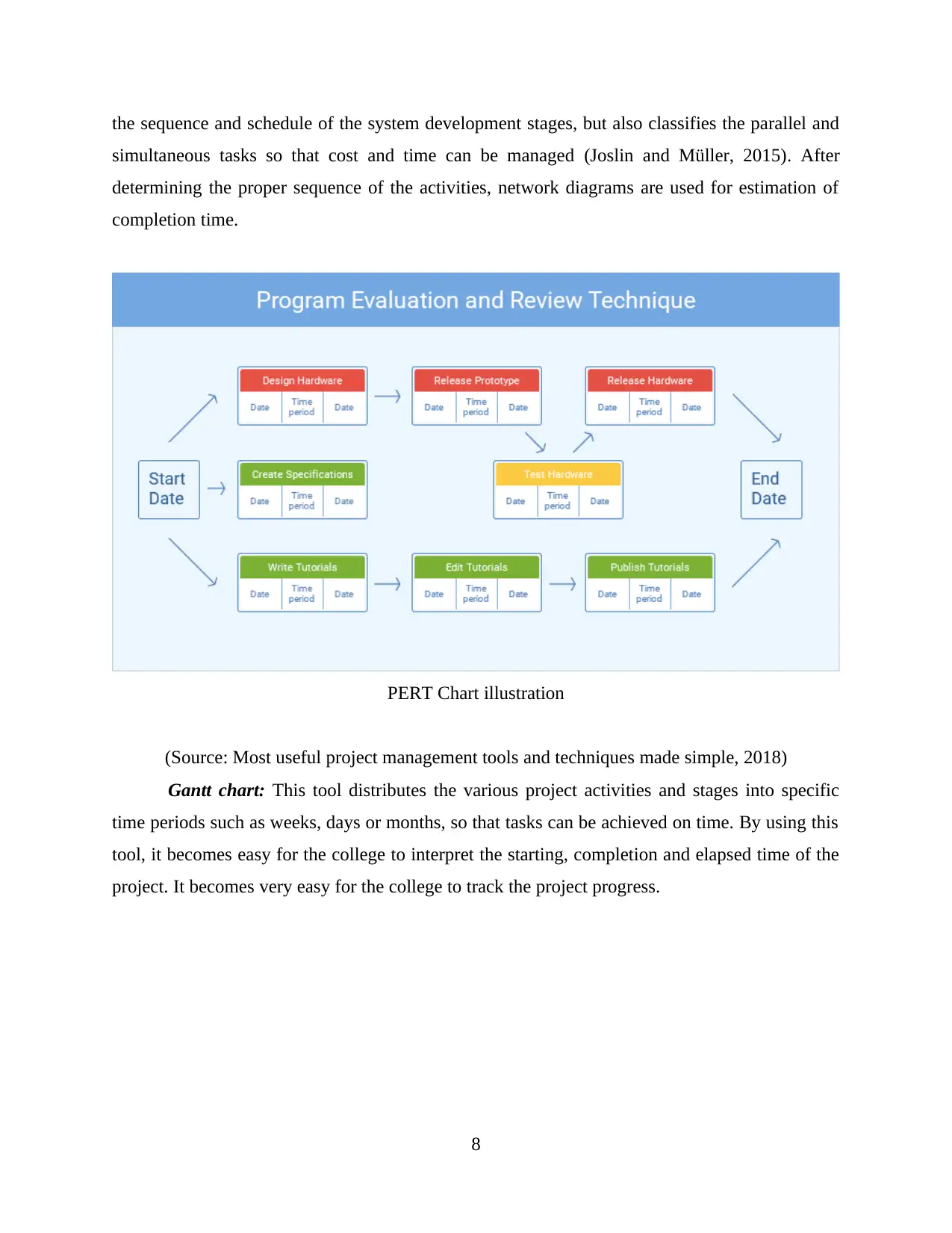
the sequence and schedule of the system development stages, but also classifies the parallel and
simultaneous tasks so that cost and time can be managed (Joslin and Müller, 2015). After
determining the proper sequence of the activities, network diagrams are used for estimation of
completion time.
PERT Chart illustration
(Source: Most useful project management tools and techniques made simple, 2018)
Gantt chart: This tool distributes the various project activities and stages into specific
time periods such as weeks, days or months, so that tasks can be achieved on time. By using this
tool, it becomes easy for the college to interpret the starting, completion and elapsed time of the
project. It becomes very easy for the college to track the project progress.
8
simultaneous tasks so that cost and time can be managed (Joslin and Müller, 2015). After
determining the proper sequence of the activities, network diagrams are used for estimation of
completion time.
PERT Chart illustration
(Source: Most useful project management tools and techniques made simple, 2018)
Gantt chart: This tool distributes the various project activities and stages into specific
time periods such as weeks, days or months, so that tasks can be achieved on time. By using this
tool, it becomes easy for the college to interpret the starting, completion and elapsed time of the
project. It becomes very easy for the college to track the project progress.
8
Paraphrase This Document
Need a fresh take? Get an instant paraphrase of this document with our AI Paraphraser
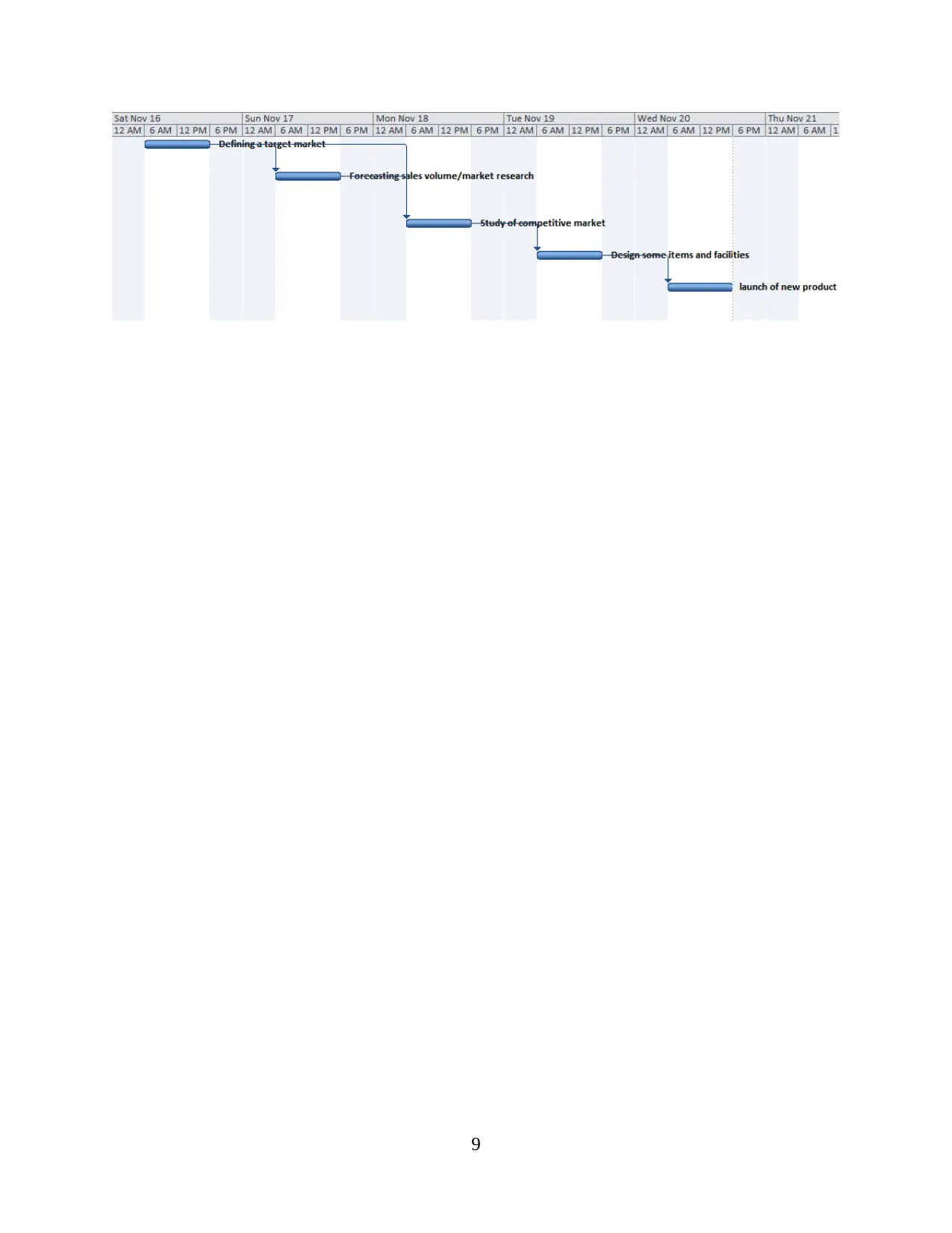
9
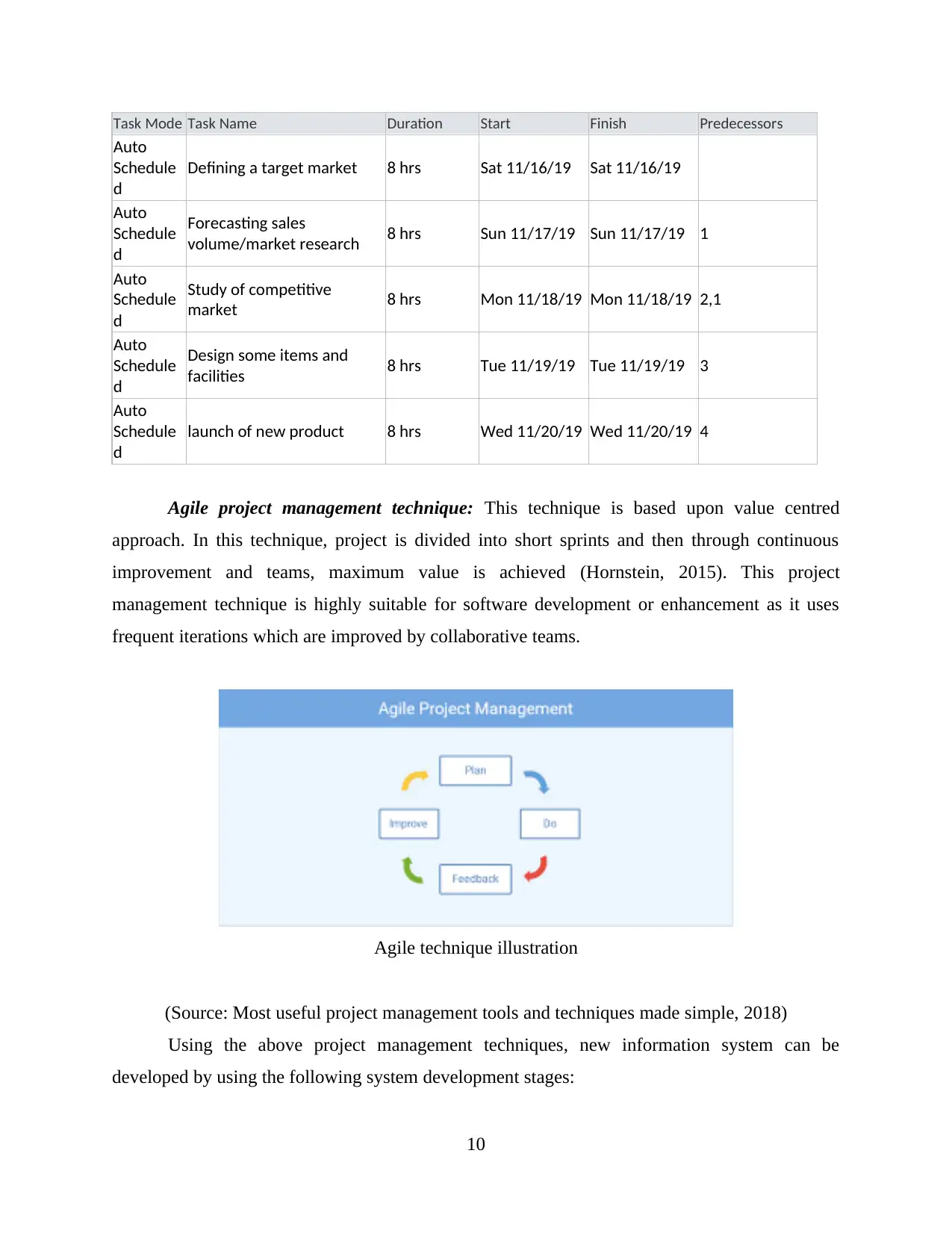
Task Mode Task Name Duration Start Finish Predecessors
Auto
Schedule
d
Defining a target market 8 hrs Sat 11/16/19 Sat 11/16/19
Auto
Schedule
d
Forecasting sales
volume/market research 8 hrs Sun 11/17/19 Sun 11/17/19 1
Auto
Schedule
d
Study of competitive
market 8 hrs Mon 11/18/19 Mon 11/18/19 2,1
Auto
Schedule
d
Design some items and
facilities 8 hrs Tue 11/19/19 Tue 11/19/19 3
Auto
Schedule
d
launch of new product 8 hrs Wed 11/20/19 Wed 11/20/19 4
Agile project management technique: This technique is based upon value centred
approach. In this technique, project is divided into short sprints and then through continuous
improvement and teams, maximum value is achieved (Hornstein, 2015). This project
management technique is highly suitable for software development or enhancement as it uses
frequent iterations which are improved by collaborative teams.
Agile technique illustration
(Source: Most useful project management tools and techniques made simple, 2018)
Using the above project management techniques, new information system can be
developed by using the following system development stages:
10
Auto
Schedule
d
Defining a target market 8 hrs Sat 11/16/19 Sat 11/16/19
Auto
Schedule
d
Forecasting sales
volume/market research 8 hrs Sun 11/17/19 Sun 11/17/19 1
Auto
Schedule
d
Study of competitive
market 8 hrs Mon 11/18/19 Mon 11/18/19 2,1
Auto
Schedule
d
Design some items and
facilities 8 hrs Tue 11/19/19 Tue 11/19/19 3
Auto
Schedule
d
launch of new product 8 hrs Wed 11/20/19 Wed 11/20/19 4
Agile project management technique: This technique is based upon value centred
approach. In this technique, project is divided into short sprints and then through continuous
improvement and teams, maximum value is achieved (Hornstein, 2015). This project
management technique is highly suitable for software development or enhancement as it uses
frequent iterations which are improved by collaborative teams.
Agile technique illustration
(Source: Most useful project management tools and techniques made simple, 2018)
Using the above project management techniques, new information system can be
developed by using the following system development stages:
10
⊘ This is a preview!⊘
Do you want full access?
Subscribe today to unlock all pages.

Trusted by 1+ million students worldwide
1 out of 21
Related Documents
Your All-in-One AI-Powered Toolkit for Academic Success.
+13062052269
info@desklib.com
Available 24*7 on WhatsApp / Email
![[object Object]](/_next/static/media/star-bottom.7253800d.svg)
Unlock your academic potential
Copyright © 2020–2025 A2Z Services. All Rights Reserved. Developed and managed by ZUCOL.




